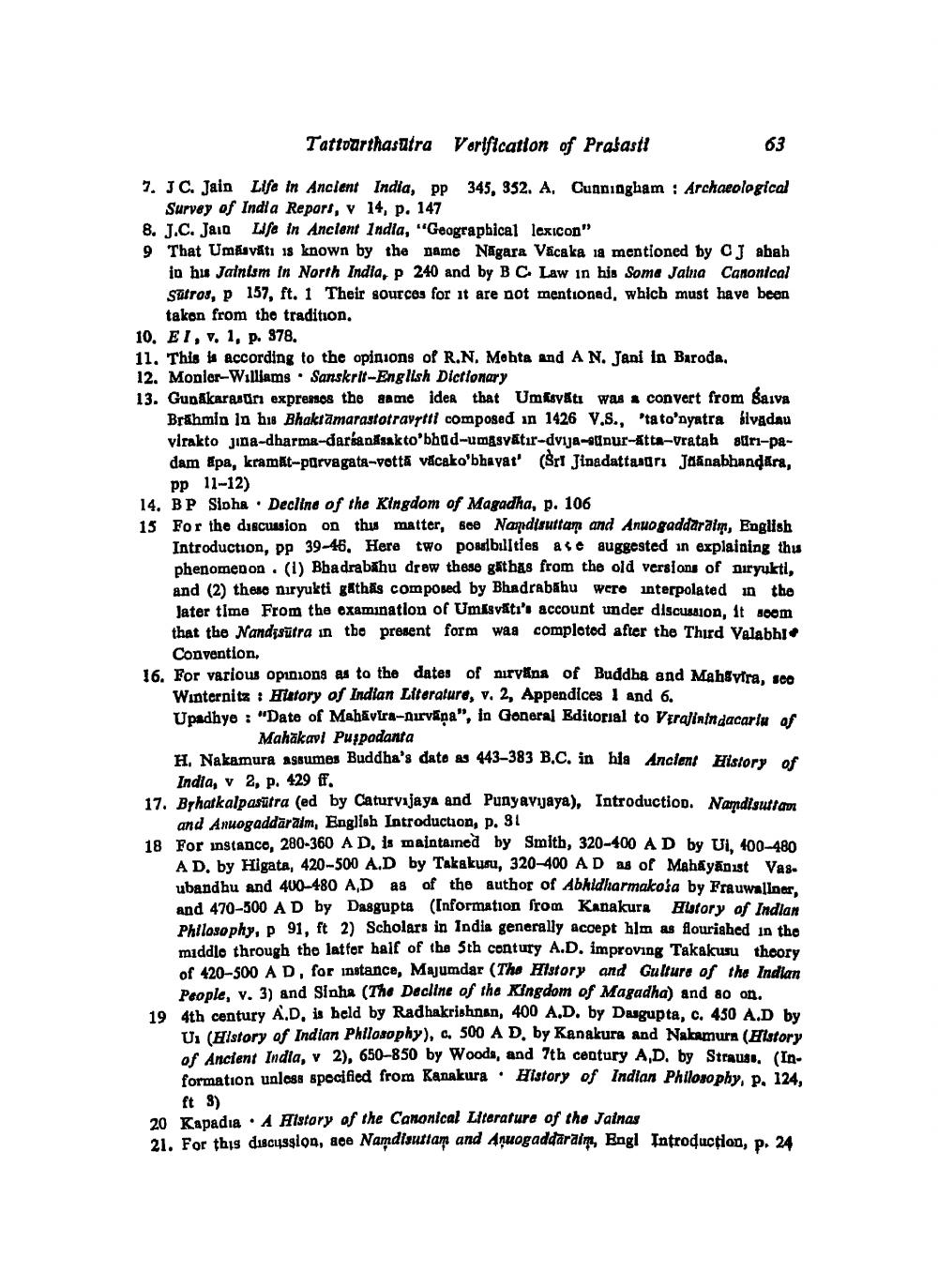________________
Tattourthasutra
Verification of Prabasti
63
7. JC. Jain Life in Ancient India, pp 345, 352. A. Cunningham : Archaeological
Survey of India Report, v 14, p. 147 8. J.C. Jaia Life in Ancient India, "Geographical lexicon" 9 That Umaavati is known by the name Nagara Vaca ka ia mentioned by CJ abah
in hu Jainism in North India, P 240 and by B C Law in his Some Jaina Canonical Sutros, p 157, ft. 1 Their sources for it are not mentioned, which must have been
takon from the tradition. 10. EI, v, 1, p. 378. 11. This according to the opinions of R.N. Mohta and AN. Jani in Baroda. 12. Monior-Williams . Sanskrit-English Dictionary 13. Gunakarasun expressos the aame idea that Umisyti was a convert from Saiva
Brahmin in his Bhaktamarastotravrtti composed in 1426 V.S., "ta to'nyatra sivadau virakto jina-dharma-darsandsakto'bhad-um svátır-dvija-sunur-Atta-vratah suri-padam apa, kramat-parvagata-vottā vacako'bhayat' (Srl Jinadattasari Janabhandara,
pp 11-12) 14. BP Sipha . Decline of the Kingdom of Magadha, p. 106 15 For the discussion on thus matter, se Nardisuttan and Anuogaddaralm, English
Introduction, pp 39-46. Here two posobilities ase auggested in explaining this phenomenon (1) Bhadrabahu drew these gåthas from the old versions of Diryukti. and (2) theo niryukti gathis composed by Bhadrababu were interpolated in the later time From the examination of UmEsvatı's account under discussion, it noem that the Nandisutra in the present form was completod after the Third Valabhi
Convention, 16. For various opinions as to the dates of nirvana of Buddha and Mahsytra. see
Winternita : Hlatory of Indian Literature, v. 2, Appendices 1 and 6. Upadhyo : "Date of Mah vira-Airvana", in Goneral Editorial to Verafinindacariu of
Mahakavi Puspadanta H. Nakamura assumes Buddha's dato as 443-383 B.C. in hla Ancient History of
India, v 2, p. 429 ff. 17. Brhatkalpasutra (ed by Caturvijaya and Punyavijaya), Introduction. Namdisuttan
and Anuogaddāraim, English Introduction, p. 31 18 For instanco. 280-360 AD, Is maintained by Smith, 320-400 AD by Ul. 400-480
AD by Higata, 420-500 A.D by Takakuru, 320-400 AD as of Mahāyān ist Vas. ubandhu and 400-480 A,D as of the author of Abhidharmakosa by Fra uwallner. and 470-500 AD by Dasgupta (Information from Kanakura History of Indian Philosophy, p91, ft 2) Scholars in India generally accept hlm as flourished in the middle through the latter half of the 5th contury A.D. improving Takakusu theory of 420-500 AD, for instance, Majumdar (The History and Gulture of the Indian
People. v. 3) and Sinha (The Decline of the Kingdom of Magadha) and so on. 19 4th century A.D, is held by Radhakrishnan, 400 A.D. by Dasgupta, c. 450 A.D by
U. (History of Indian Philosophy), c. 500 AD. by Kanakura and Nakamura (History of Ancient India, v 2), 650-850 by Woods, and 7th century AD. by Strauss, (Information unless specified from Kanakura. History of Indian Philosophy, p. 124,
ft ) 20 Kapadia A History of the Canonical Literature of the Jainas 21. For this discussion, ace Namdisuttam and Anuogaddaraim, Engl Introduction, p. 24
of 420-500 A Da Sinha (The Decline tofnan, 400 A.D. by Dasgupta famura (History




